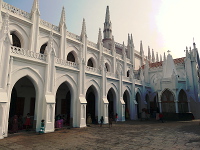
Basilica
San Thome
|
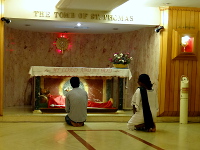
Tomb of St. Thomas
|
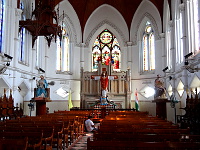
Inside the cathedral
|
|
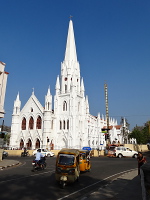
The cathedral in Mylapore
|
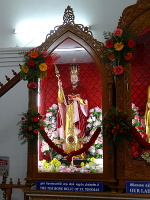
The saint's toe
|
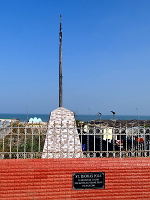
Pole of St. Thomas
|
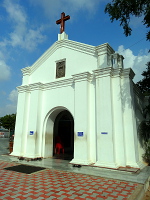
Portuguese chapel
|
|
|
Christians only make up
about 2% of India’s population, but in a country with over
1.2 billion people, that adds up to quite a few. While
there are several reasons for their presence, such as the
influence of European colonial powers like the British,
Dutch, Portuguese, and French or the allure of moving away
from caste-conscious religions, credit is also given to the
missionary efforts of the apostle Thomas. St. Thomas
arrived in southern India from Syria around 52 AD and was
fairly effective at converting the locals to Christianity.
In truth, he was so prolific that one of the local rulers
had him neutralized.
There are three key sites
around Chennai associated with the story of St. Thomas.
Little Mount, or Chinnamalai, is a small hill along the
Adyar River not far from my apartment – in fact, I walked
there one afternoon. Legend has it that Thomas lived here
in a small cave for several years preaching to his ever
growing flock. When his persecutors tried to corner him, an
opening in the cave appeared allowing him to escape. Today,
the area is surrounded by urban sprawl and a polluted river
but the presence of Thomas is marked by a church built by
the Portuguese in 1551.
Thomas took refuge on a
larger hill to the south called St. Thomas Mount or
Parangimalai where he spent his time praying and watching
his back. Under pressure from his Brahmin advisors, the
king of Mylapore, supposedly condemned Thomas to death.
And so it was on this hill that his assailants speared him
to death in 72 AD. The devout can climb the 150 plus steps
to visit the 16th century church at the summit of the mount,
but I took the easy way and had the driver drop me at the
top. There were a fair number of people about but most were
crowded in one corner watching the airplanes take off from
the adjacent Chennai airport. As I walked around snapping
some photos of the view of the city, I was approached by a
little man demanding a church donation for taking pictures.
I’m not sure that he knew what the word "donation" meant, but
I saw no harm in giving him 20 rupees (about 40 cents) for
the cause.
Thomas’s remains were
interred in a church that the apostle himself commissioned. In
the 16th century, the Portuguese built a new church in his
honor at Mylapore, but there exists some controversy over
the location of Thomas’s remains. It is generally accepted
that his body, a jar of bloodied soil, and the
spear that killed him were interred in his own church in Mylapore. In the mid-13th century, many believe that the
remains were moved to Ortona, Italy via Greece and that only
a finger (no doubt the one used to probe Jesus’s wounds),
toe and
the spear tip remain in India. Undeterred, the Portuguese
built a new church to house the tomb in Mylapore, only the
third church in Christendom to be built on the tomb of an
apostle. The British built the present structure on the
same site in 1893.
Since I only had Sundays off, I had to visit the Basilica San Thome
while it was in full use.
There are a number of masses each Sunday – in English, Malayalam,
and Tamil to accommodate the variety of parishioners.
I found a window of opportunity between the last mass and a
wedding to have a look around.
In a city where maintenance of buildings and public spaces is
virtually non-existent, the cathedral is in immaculate condition and
has a few unique features like open air sides to accommodate mass
overflow and a sculpture of Jesus emerging from a lotus guarded by
peacocks.
A separate entrance leads to the crypt and the tomb of St. Thomas, and
in line with Hindu tradition, visitors are required to remove their
shoes before entering the crypt.
I descended the marble stairs mumbling a short prayer in hope
that my shoes would still be there when I resurfaced.
The crypt was a little kitschier than I expected with a large
mural of the saint’s martyrdom and a makeshift gift area.
The room with the tomb is finished in gleaming marble with
pews available for the devout.
There were several people on their knees, and it was very
clear that this was a special place for Christian Indians.
Somewhat inconspicuously located behind the church is a tall wooden
pole that was allegedly placed there by the apostle himself to
protect the area from encroaching waters.
According to legend an enormous tree had fallen across the
river causing a flood in Mylapore.
Despite the efforts of the locals to move the log, only
Thomas could budge it. He had
a long wooden post made from the log and stuck in the ground near
the shore claiming that the waters would never overrun the land past
this mark. As the 2004
Tsunami wreaked havoc in southern Asia, the Basilica San Thome and
the surrounding neighborhood were spared the devastation.
|
|
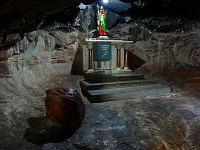
Thomas's cave at Little Mount
|
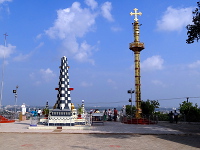
On Thomas Mount
|
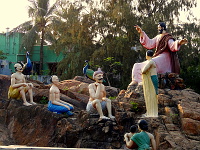
Thomas gives a sermon
|
|
|
|
The historical
socio-economic class structure of India, known as the caste
system, is one of the more infamous aspects of Indian
society. Despite efforts over the last half century to rid
themselves of the influence of castes, vestiges are still
apparent. The origins of castes seem too complicated for a
simple mind like mine, but they stem from Hindu classical
beliefs in which the supreme being Purusha is sacrificed and
his body used to create the world. His head became the
pinnacle of society, the Brahmans, consisting of spiritual
leaders and teachers. His arms formed the Kshatriyas
comprising rulers and warriors. His legs became the class
of farmers and merchants known as the Vaishyas. Finally,
his feet created the lowest class of society called Shudras
who were meant to serve the other classes. Those born
outside the caste system, known as Dalits today, were
“outcastes” or “untouchables” because of the belief that
they would pollute members of a Hindu caste if they came
into physical contact – a punishable offense. This lowest
level of society dealt primarily with the dead, dirt, and waste.
The word “caste” is
actually a Portuguese term adopted by the British. To
Hindus, the four castes were known as varnas, and some have
defined this Sanskrit term to mean “color”. While colors
were assigned to each caste (white for Brahmans and black
for Shudras), it is not clear that they represented skin
color, but higher caste members have had lighter skin that
has traditionally been associated with wealth, power, and
success. What is clear is that virtually none of the
people on TV, in movies, or in magazines look much like the
dark-skinned people of South India. While women in the US
wrestle with body image and being tanned, women in India are
obsessed with becoming the light-skinned “fairs” that they
see on TV and in Bollywood movies. The stores have whole
aisles dedicated to skin lightening creams like Fair Look,
Fair Pro, Fair & Flawless, and even Fair & Handsome for
men. The TV is inundated with infomercials for Fair and
Lovely showing sad, dejected people with obvious brown
makeup who miraculously have their lives changed for the
better by using skin whitening cream.
|
|
|
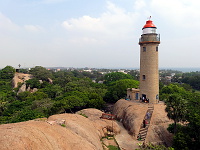
English lighthouse
|
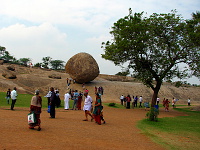
Krishna's Butterball
|
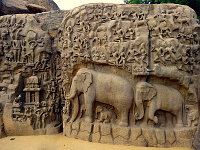
Arjuna's Penance
|
|
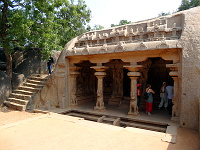
Varaha Cave Temple
|
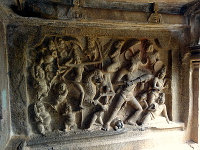
Temple bas-relief
|
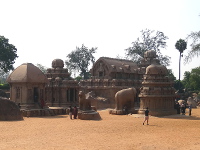
The Five Rathas
|
|
|
I spent the better part
of December on two major challenges. One was the
inauguration of our new R&D center in Chennai, and the other
was the preparation of a trip up to the north of India with
the wife. The R&D center opened without a hitch but with a
lot of long days and nights leading up to it. Prior to the
ribbon cutting involving dignitaries, we had an intimate
puja attended by the staff to ensure the success of the new
labs.
My attention then turned
to making arrangements for a 10-day journey to visit Delhi,
Agra, and Jaipur. I had not really been out of the Chennai
area since I arrived, and I was really looking forward to
seeing more of India. Since the wife had never been to
India, I was also eager to make it as pleasant an experience
as possible for her and made travel arrangements that were
acceptable to her standards. We experienced many
interesting and beautiful things during the trip – too
numerous to mention here.
After we arrived back in Chennai and just before the
missus headed back to the US, we went south to spend the
night in a cozy cottage at a top-notch seaside resort and
visit the temple complex at Mahabalipuram. Dating from the
7th century, these temples are all that survive from a
Pallava port city that was once bustling with activity.
First up were the Five Rathas which are carved top down from
single pieces of granite. The diverse architecture has led
some to believe that they were actually remnants of an
ancient school
for sculpture. In any case, the art is alive and well in
the surrounding town as the streets are lined with granite
and marble sculpture shops hawking animals and deities of
all sizes. Not far away is a park with more temples and a
large precariously positioned boulder known as Krishna’s
Butterball. Visitors love to pose under and beside this
monolith. Someday I will read about the carnage that ensued
when it finally rolls down that hill.
Our last stop was the jewel in the crown – the seaside
Shore Temple. Historical accounts from visitors such as
Marco Polo mention that there were in fact seven temples on
this site, but this was always considered folklore.
Ironically, it was the Tsunami of 2004 that shed some light
on the mystery. As the waters receded some 500 yards prior
to the arrival of the enormous wave, eyewitnesses saw stone
walls projecting out of the sea floor. Subsequent
underwater investigations have shown that there was indeed a
complex of buildings of some sort that had been reclaimed by
the Bay of Bengal. During our visit, the temple had been
overrun not by waves but by school children. Minutes after
we arrived, we were followed by two bus-loads of screaming,
uniformed school kids. We cringed as we saw them try to
climb the 1,200 year old temple walls and ride the animal
sculptures. If field trips like that are allowed to
continue, the seventh temple might also soon disappear.
|
|
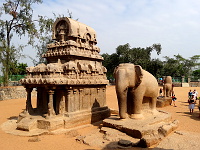
Elephant and Ratha
|
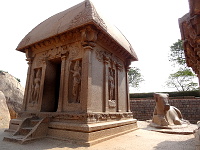
Bull
|
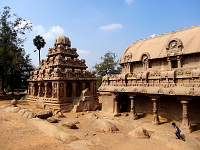
Monolithic Hindu temples
|
|
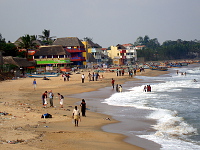
Beach scene
|
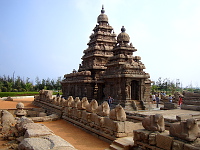
Shore Temple
|
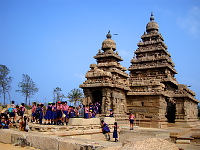
Attack of the school children
|
|
|

